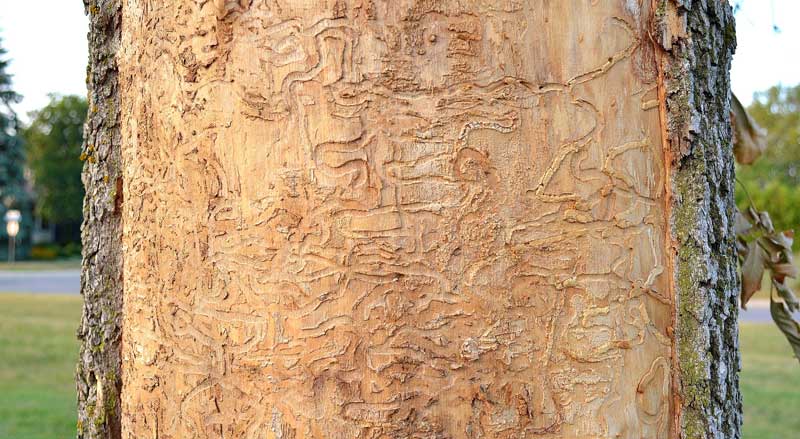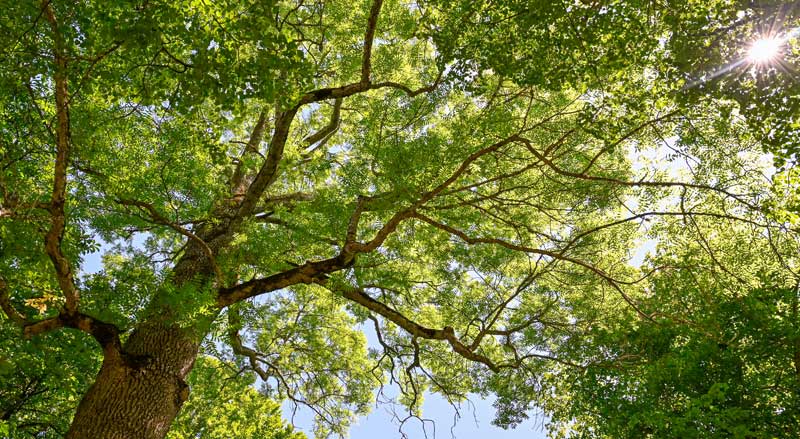Unfortunately, a formidable insect pest is threatening this beloved tree’s very existence—the emerald ash borer (EAB). Millions of ash trees in the U.S, have been killed by this pest. These dead and dying trees pose a deadly risk to people and their property.
The ash tree is a favorite of many people. This magnificent tree grows up to 75 feet tall and can reach a diameter of 24 inches. The column-like trunk often grows straight up toward the sky. People have long associated the ash tree with knowledge and spirituality.
The wood of the ash tree is extremely long and has a pleasing light color and straight grain. People create furniture, staircases and stair treads, moldings, tools and even baseball bats from this valuable hardwood.
The Emerald Ash Borer in the United States
The emerald ash borer originated in Asia. Experts believe it was originally brought to the US in the 1990s in infected ash wood, packing containers, or wood packing materials.
The invasive emerald ash borer was first identified in the United States in 2002 in southeast Michigan. The New Jersey Department of Agriculture found this invasive insect in Somerset County, New Jersey, in 2014. Since then, it has spread to all New Jersey counties.
Today, in 2023, the U.S. Department of Agriculture reports that these insect infestations exist in 36 states, as well as the District of Columbia. They report that EAB infestations have already killed hundreds of millions of ash trees in North America.
Damaged Ash Trees Put People, Pets, and Property at Risk
Ash trees are tall and stately. And it’s their very height that, in part, makes infected trees so dangerous.
As the larvae feed and the tree’s vascular system becomes damaged and ineffective, the wood becomes dry and brittle. The decrease in moisture and nutrients weakens the entire tree and branches are prone to cracking and breaking. Since this damage isn’t visible to homeowners, property owners are often caught off guard when large branches break off and fall.
Tree limbs, especially those high up, can fall at any time—not only during a bad storm. In fact, homeowners are finding that large branches, as far as 40 feet up or even higher, can fall on the calmest of days. A branch falling from this height can cause an incredible amount of destruction below.
Unfortunately, falling ash trees and branches have injured and even killed people. Patch, an online NJ news magazine, reports that Chester NJ officials have urged residents to remove all dead ash trees on their property to prevent a property hazard. In fact, Chester Borough has already removed many large ash trees since 2019.
Decay and Danger Continues for Years
Once an ash tree dies, fungi slowly feed on the tree, contributing to its decay. So, sometimes, a standing ash tree can be dead for several years before it falls because of overall weakness and rot.
A word of caution—just because an ash tree has been standing for a long time, doesn’t mean it will stay that way.
Tree professionals often encourage homeowners to remove damaged trees to protect nearby trees from infestation, and nearby structures and people from falling branches.
This dangerous but necessary job should be done by professionals with the knowledge and equipment to remove trees safely.
How to Identify the Emerald Ash Borer
Green is a beautiful color found in nature. But don’t let the EAB’s vibrant green appearance fool you. It is an invasive species deadly to ash trees.

When an emerald ash borer beetle reaches maturity, it’s about one-half inch long and one-eighth inch wide. It has a metallic, emerald green color.
The mature emerald ash borers are not particularly damaging to trees. At most, they will eat the leaves. But it is the female EAB eggs that pose a serious problem for ash trees alone.
Female EAB’s deposit eggs on the bark of live ash trees. When these larvae hatch, they bore into the bark of the tree. The larvae feed on the ash trees and cause irrevocable damage since the trees’ vascular systems exist directly beneath the bark.
This ring of essential conducting tissue transports water and nutrients to all areas of the tree. When the feeding EAB larvae cause tissue damage, the tree can no longer transport water and nutrients to other parts of the tree. The tree will eventually die in 3-5 years.
How to Recognize an Infested Ash Tree

In the beginning, the tree’s top branches—its canopy—begin to die and leaf density thins. Eventually, the tree looks bare. However, you will see new sprouts growing from the roots and trunk of the tree. It’s recommended that you should remove ash trees if over 30% of their canopy is missing.
As insect damage progresses downward, you can see telltale signs on the lower parts of the tree. But while damage is still high up, it may be difficult for the homeowner to see it—these majestic trees are quite tall.
However, damage will quickly progress, and once strong, stately trees lose a great deal of bark on their trunks and limbs.

Eventually, the bark on the tree splits and you can see S-shaped galleries that define the path of the EAB infestation. On close examination, you will also see D-shaped exit holes created by the mature beetles when they emerge in the spring.
Woodpeckers like to feast on EAB larvae. So, if you notice increased woodpecker activity around an ash tree, it’s a good sign that your tree needs to be inspected.
Commonly, you will find collections of bark flakes directly beneath infested trees; woodpeckers enthusiastically remove the ash tree’s bark in search of EAV larvae.
This bark destruction is called “blonding.” It gets its name from the fact that the ash tree’s healthy greyish brown bark changes to a lighter beige or “blonde” color. Blonding is a sign that the tree has an advanced EAB infestation.
Swift Action Is Needed to Prevent or Eliminate EAB Infestation
If you suspect an EAB infestation, you need to take swift action. You may save a tree if it’s treated early. And you can stop the infestation from spreading to other nearby trees. But let it go too long, and the ash tree, or trees, will die.
These days, New Jersey homeowners with ash trees on their property need to be especially vigilant and proactive.
Tree professionals can inject ash trees with specific insecticides to prevent emerald ash borer infestation. These treatments last for two seasons and will need to be repeated.
These treatments are mainly preventative. They must be applied early before a tree has sustained major damage. Treatment can’t be successful if there’s lots of bark destruction on the tree.
Unfortunately, damaged tree branches will never come back to life—even if the tree is saved.
Protect Your Trees Now

If you have ash trees on your property, you need to have them professionally inspected, evaluated, and treated.
At Trees Unlimited, we can help keep your trees healthy, cared for, and protected.
Contact us at Trees Unlimited for complete and expert tree care.




